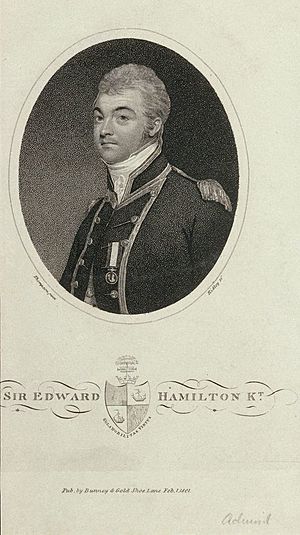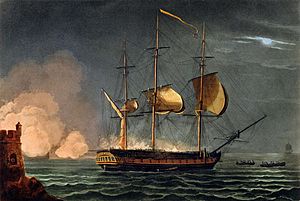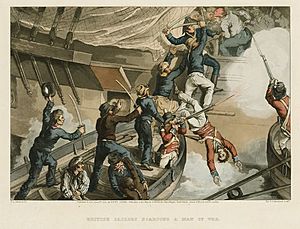Sir Edward Hamilton, 1st Baronet facts for kids
Quick facts for kids
Sir Edward Hamilton
|
|
|---|---|
 |
|
| Born | 22 March 1772 |
| Died | 21 March 1851 17 Cumberland Terrace, Regent's Park, London |
| Allegiance | United Kingdom of Great Britain and Ireland |
| Service/ |
Royal Navy |
| Years of service | 1777 – 1851 |
| Rank | Admiral |
| Commands held | HMS Comet HMS Surprise |
| Battles/wars | Battle of the Hyères Islands Cutting-out of HMS Hermione |
| Awards | KCB |
| Relations | Sir John Hamilton (father) Sir Charles Hamilton (brother) |
Admiral Sir Edward Joseph Hamilton, 1st Baronet KCB (born March 22, 1772 – died March 21, 1851) was a brave officer in the Royal Navy. He served during the French Revolutionary and Napoleonic Wars, eventually becoming a high-ranking admiral. He is most famous for a daring mission to recapture a British ship from the Spanish.
Contents
Edward Hamilton was born on March 22, 1772. His father, Sir John Hamilton, was also a captain in the navy. Edward first joined his father's ship, the 74-gun HMS Hector, when he was just five years old. He officially started serving as a midshipman at age seven in 1779.
After the war, he returned to England and went to the Royal Grammar School, Guildford. He went back to sea in 1787, serving on HMS Standard for three years. In 1790, he passed his lieutenant's exam and joined HMS Melampus.
Serving in the French Wars
When war broke out with Revolutionary France in 1793, Edward Hamilton returned to active duty. He served on Lord Howe's flagship, HMS Queen Charlotte. Later, he moved to his brother's ship, HMS Dido, and became a lieutenant in October 1793.
While on the Dido, he showed great courage. He led a small boat with only eight sailors to capture a grounded enemy privateer. He put out a fire the enemy had started and then went ashore to capture the escaped crew. He also helped during the siege of Bastia. He commanded 100 British and 300 Corsican soldiers, building defenses close to the enemy. After 13 days of fighting, the enemy surrendered.
In 1794, he returned to HMS Victory. He was promoted to first lieutenant. In 1795, he was part of the Naval Battle of Hyères Islands. Soon after, Admiral Jervis took command and promoted Hamilton to commander in 1796. He was given command of the fireship HMS Comet.
Becoming a Captain
Edward Hamilton was promoted again to post-captain in June 1797. He first served on HMS San Josef, a large ship captured by the British. Then, he was transferred to the 24-gun HMS Surprise. He sailed to Newfoundland and then to Jamaica, where he served until 1800. He was a very successful captain, capturing or destroying over 80 enemy ships.
The Daring Rescue of the Hermione
The most famous event in Hamilton's career was recapturing the former HMS Hermione. This ship had been part of the Royal Navy. In 1797, its crew had mutinied, killing their captain and other officers. They then sailed the Hermione to a Spanish port and gave it to the Spanish authorities. The Spanish renamed the ship Santa Cecilia.
When Admiral Parker heard the Santa Cecilia was in Puerto Cabello, he ordered the Surprise to watch it. Captain Hamilton felt it was his duty to get the ship back for the Royal Navy. He planned a risky mission to sneak into the harbor and take the ship. He asked for more men, but Parker thought it was too dangerous and refused. Hamilton decided to go ahead anyway.
Hamilton led about 100 sailors and soldiers in small boats towards the Santa Cecilia. The enemy ship had around 400 Spanish sailors and was protected by two shore batteries with 200 guns. Despite the odds, Hamilton and his men fought their way onto the ship. They bravely defeated the Spanish defenders and sailed the Hermione out of the port.
The Spanish lost 119 men, and 231 were taken prisoner. The British, amazingly, did not lose a single man. Only 11 British sailors were wounded, including Hamilton himself. He was hit in the head and had cuts from a sword and pike. After being recaptured, the Hermione was renamed HMS Retaliation, and then HMS Retribution.
Awards and Later Life
Hamilton was praised for his incredible bravery. The government in Jamaica gave him a sword worth £300. King George III made him a Knight Bachelor in 1800. He also received a Naval Gold Medal for his actions. The City of London made him a "freeman" and gave him a valuable gold box.
While recovering from his wounds, Hamilton was sailing home when his ship was captured by the French. He was taken prisoner to Paris. He spent six months in prison before being released in a prisoner exchange. When he finally reached London, he was celebrated at a special banquet. He was offered a pension for his wounds, but he turned it down. He was already wealthy from prize money and wanted to continue serving in the navy.
Later in his career, Hamilton continued to receive promotions based on his long service. He became a rear-admiral in 1821, a vice-admiral in 1837, and finally a full admiral in 1846. He was also made a KCB and a baronet. Sir Edward Hamilton passed away on March 21, 1851, at the age of 79. His son, Edward Hamilton, inherited his title.
|



